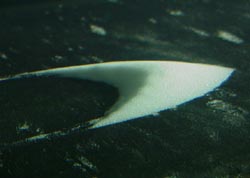Underwater Desert

Windblown dunes can engulf houses, roads, and airfields, but researchers have had a hard time studying them under controlled conditions. For one thing, tabletop-sized dunes aren’t normally stable. Now a team publishing in the 23 December print issue of PRL reports it has generated miniature replicas of crescent-shaped dunes known as barchans in a water tank. At the same time, they say they have verified a basic principle of dune formation. The researchers hope their technique will improve understanding of dune formation and stability as well as related phenomena, such as seashore evolution.
Barchans are a common type of dune, typically 1 to 10 meters high, driven by wind, and found from Namibia to Mars. They can be up to 100 meters long in the direction the wind blows but have not been observed shorter than 10 meters long. Here’s how a decades-old theory explains this minimum size: As air moves across a flat desert, it carries a limited amount of airborne sand. When the moving air hits a sand pile, the speed increases a bit, which allows it to carry more grains. But the air must travel some distance before it picks up enough sand to become saturated again, so at the leading edge of the dune, more sand is picked up than is dropped down. For a large dune, the air saturates before reaching the end of the pile, and there is no net gain or loss of sand. But if the dune is too short–shorter than the so-called flux saturation length–the air never reaches its saturation point, and the dune suffers erosion.
The theory agrees with field observations and with existing experimental data, but dune experiments have always been complicated by many factors, including the large volumes of sand needed. To make stable barchan dunes of a size that fits their lab, Pascal Hersen of the École Normale Supérieure in Paris and his colleagues used water instead of air. They expected the higher density of water to dramatically decrease the saturation length. Instead of sand, they used 150-micron-diameter glass beads. They placed a tray piled with beads on a sort of underwater treadmill. The machine alternately jerked the tray forward quickly and then pulled backward slowly enough to keep the beads in place, simulating intermittent winds. Barchans formed automatically, at 1 to 10 centimeters long and 1 to 10 millimeters high–1/1000 the scale of those in the desert. The proportions matched those of real dunes, and the team’s detailed measurements of dune size and motion apparently confirm the existence of a flux saturation length.
Hersen says he ultimately wants to study phenomena such as dune collision and nucleation and that this work could lead to a better understanding of the physics of grains in processes such as sedimentation. Antonello Provenzale of the University of Turin calls it “excellent work” that provides a starting point for future research, such as the role vegetation plays in stabilizing dunes or the formation mechanisms of more complex sand piles called star dunes. But Hans Herrmann of the University of Stuttgart cautions that the grains in these underwater dunes behave differently from those in natural barchans: windblown grains move in hops, whereas the beads in these experiments are pulled directly by the viscous flow of water. Hersen counters that these artificial dunes have exactly the same proportions as natural barchans, so the particular motions of grains may not be very important.
–Charles Choi
Charles Choi is a freelance science writer in New York City.
More Information
Response to this paper: Phys. Rev. Lett. 93, 039401 (2004).


